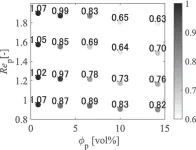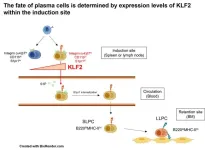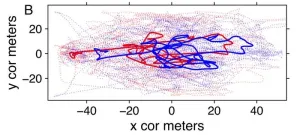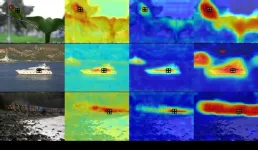(Press-News.org) The mass extinction that ended the Permian geological epoch, 252 million years ago, wiped out most animals living on Earth. Huge volcanoes erupted, releasing 100,000 billion metric tons of carbon dioxide into the atmosphere. This destabilized the climate and the carbon cycle, leading to dramatic global warming, deoxygenated oceans, and mass extinction. However, many plants survived, leaving behind fossils which scientists have used to model a dramatic 10 degree rise in global temperatures.
“While fossilized spores and pollen of plants from the Early Triassic do not provide strong evidence for a sudden and catastrophic biodiversity loss, both marine and terrestrial animals experienced the most severe mass extinction in Earth’s history,” explained Dr Maura Brunetti of the University of Geneva, lead author of the article in Frontiers in Earth Science. “Life on Earth had to adjust to repeated changes in climate and the carbon cycle for several million years after the Permian-Triassic Boundary.
“Our study links land plant macrofossil assemblages and numerical simulations describing possible climates from the late Permian to the early Triassic. We show that a shift from a cold climatic state to one with a mean surface air temperature approximately 10⁰C higher is consistent with changes in plant biomes.”
Climate crisis
The scientists studied five stages on either side of the Permian-Triassic Boundary: the Permian Wuchiapingian and Changhsingian, the early Triassic Induan and Olenekian, and the middle Triassic Anisian. They combined a map of Earth’s geography at that time with plant fossil data, assigning plant genera to six major biomes to estimate what the local climate looked like in different places based on the plants found there. Changes over time in the fossil record served as observational data to test the scientists’ climate models.
These biomes ranged from hot, humid ‘tropical everwet’ biomes, to seasonal tropical or temperate biomes and desert biomes. Different temperatures and CO2 levels favor different biomes. In cold temperature states, tropical latitudes feature desert, while at higher latitudes cold-temperate vegetation and tundra appear. Hot states feature temperate vegetation at polar latitudes and desert at equatorial latitudes. The more CO2 is present, the warmer and wetter biomes are.
The seeds of recovery
The scientists then used statistical analysis to estimate the similarity between the existing plant fossil records and simulations of the biomes that would have flourished in different temperature states and CO2 levels. They found that these biomes changed dramatically at the Permian-Triassic Boundary, as the planet moved from a cold climate to a warm one.
The earliest periods, in the Permian, were cold, while the first period of the Triassic — the Induan — had a disturbed climate which the scientists couldn’t identify. This could be caused by sampling biases or poorer fossil preservation, or it could be due to short-term climate oscillations which didn’t allow biomes to stabilize. We need more fossil data to clarify this.
The later Triassic, however, was much hotter. The following periods — the Olenekian and Anisian — stabilized at temperatures 10 degrees higher than previously.
Heating up
“This transition from the colder climatic state to the hotter state is marked by an increase of approximately 10⁰C in the mean global surface air temperature and an intensification of the water cycle,” said Brunetti. “Tropical everwet and summerwet biomes emerged in the tropics, replacing predominantly desertic landscapes. Meanwhile, the warm-cool temperate biome shifted towards polar regions, leading to the complete disappearance of tundra ecosystems.”
“The shift in vegetation cover can be linked to tipping mechanisms between climatic steady states, providing a potential framework for understanding the transition between Permian and Triassic,” added Brunetti. “This framework can be used to understand tipping behavior in the climate system in response to the present-day CO2 increase. If this increase continues at the same rate, we will reach the level of emissions that caused the Permian-Triassic mass extinction in around 2,700 years — a much faster timescale than the Permian-Triassic Boundary emissions.”However, as with the climate of the Induan period, more data and more refined models are needed for clearer results.
“The comparison between simulated biomes and the dataset is influenced by uncertainties, arising from paleogeographic reconstructions and the classification of fossil assemblages into biomes,” cautioned Brunetti. “Furthermore, our climate modeling setup relies on offline coupling between models — the vegetation model uses the final outputs of the climatic model for biome reconstruction. This could be enhanced using a dynamic vegetation model.”
END
New research reveals how a 252 million year old climate crisis accompanied the ‘Great Dying’ mass extinction event, completely reorganizing the Earth’s ecosystems
By comparing climate models to fossil vegetation, scientists trace the remains of climate chaos following the Permian-Triassic mass extinction — including 10 degrees of global warming caused by CO2 emissions
2025-03-11
ELSE PRESS RELEASES FROM THIS DATE:
Untangling quantum entanglement with new calculation formulas
2025-03-11
Once described by Einstein as “spooky action at a distance,” quantum entanglement may now seem less intimidating in light of new research findings.
Osaka Metropolitan University physicists have developed new, simpler formulas to quantify quantum entanglement in strongly correlated electron systems and applied them to study several nanoscale materials. Their results offer fresh perspectives into quantum behaviors in materials with different physical characteristics, contributing to advances in quantum technologies.
Quantum entanglement is a unique phenomenon ...
Adults abused as children twice as likely to develop health and mental health conditions
2025-03-11
Toronto, ON – A new study published this week in Child Maltreatment found that in comparison to those who had not been abused in childhood, adults who had experienced both childhood physical and sexual abuse had approximately double the odds of physical and mental health conditions, including angina, arthritis, asthma, COPD, heart attack, depression, and disability -- even after considering respondents’ age, race, income, and health behaviors, as well as obesity.
Those who had been sexually abused, but not physically abused, were 55% ...
A dive into erythritol slurry and its potential for waste heat recovery
2025-03-11
Energy efficiency is crucial for sustainability, yet vast amounts of low-temperature waste heat remain unused in industrial processes. Now, researchers from Japan have investigated erythritol slurry as a promising heat transfer medium for thermal storage and transport. By analyzing its flow behavior and non-Newtonian properties, they developed a predictive equation for its rheological characteristics. Their findings could help guide the design of industrial waste heat recovery systems, advancing energy efficiency and carbon neutrality.
Energy efficiency is one of the most important pillars of our global sustainability goals. Simply put, one of the most straightforward and effective ...
No place like home—how proteins that plasma cells express at their origin affect migration
2025-03-11
Osaka, Japan – Vaccine effectiveness relies on creating a strong antibody response that can be reactivated to fight future infections. Now, researchers from Japan report that antibody-producing cells are destined for longevity from the moment they are born.
In a recent study published in the Journal of Experimental Medicine, a multi-institutional research team led by Osaka University reveals that a key cell population involved in long-term immunity to infection is programmed early in its lifecycle to travel to protected sites in the body.
Plasma cells originate in lymphoid ...
Socioeconomic factors fuel global inequalities in Alzheimer's disease burden, study finds
2025-03-11
Ann Arbor, March 11, 2025 – An analysis of the global burden and temporal trends of Alzheimer's disease and other dementias (ADODs) reveals significant cross-country inequalities associated with a series of sociodemographic development-related risk factors, such as education, income, fertility, and health expenditure. The new study in the American Journal of Preventive Medicine, published by Elsevier, calls for the development of targeted prevention and control strategies in different countries.
The burden of ADODs has risen globally over the past three decades. The authors of this first systematic and comprehensive global study analyzing ...
Foraging footballers suggest how we come together to act as one
2025-03-11
What do albatrosses searching for food, stock market fluctuations, and the dispersal patterns of seeds in the wind have in common?
They all exhibit a type of movement pattern called Lévy walk, which is characterized by a flurry of short, localized movements interspersed with occasional, long leaps. For living organisms, this is an optimal strategy for balancing the exploitation of nearby resources with the exploration of new opportunities when the distribution of resources is sparse and unknown.
Originally described in the context of particles drifting through liquid, Lévy walk has been found to accurately describe a very wide range of phenomena, from cold atom dynamics to ...
SSA: Semantic Structure Aware Inference for Weakly Pixel-Wise Dense Predictions without Cost
2025-03-11
CAM is proposed to highlight the class-related activation regions for an image classification network, where feature positions related to the specific object class are activated and have higher scores while other regions are suppressed and have lower scores. For specific visual tasks, CAM can be used to infer the object bounding boxes in weakly-supervised object location(WSOL) and generate pseudo-masks of training images in weakly-supervised semantic segmentation (WSSS). Therefore, obtaining the high-quality CAM is very important to improve the recognition performance of weakly supervised pixel-wise ...
New test helps doctors predict a dangerous side effect of cancer treatment
2025-03-11
Fukuoka, Japan — Medical researchers in Japan have discovered a way to predict a potentially life-threatening side effect of cancer immunotherapy before it occurs. By analyzing cerebrospinal fluid collected pre-treatment, researchers at Kyushu University identified specific proteins associated with a damaging immune response that can affect the central nervous system after therapy. Their findings, published in Leukemia on 11 March, 2025, could make immunotherapy cancer treatment safer by helping doctors identify high-risk patients in advance, ...
UC Study: Long sentences for juveniles make reentry into society more difficult
2025-03-11
Juveniles grow up hearing a multitude of adages about life, such as: “True friends are forever,” “Fake it ’til you make it,” and “Change is a good thing.”
However, these adages — and other life advice about behavior in society — are difficult to process for juveniles who were incarcerated at a young age and served long sentences, says J.Z. Bennett, a criminologist at the University of Cincinnati whose research focuses on prison reform.
“Spending decades in prison removes individuals from social structures and sources of informal social control, such as education, employment, marriage and parenting,” he writes ...
Death by feral cat: DNA shows cats to be culprits in killing of native animals
2025-03-11
Conservation scientists from UNSW Sydney have used DNA technology to identify feral cats as the primary predators responsible for the deaths of reintroduced native animals at two conservation sites in South Australia.
The finding fits in with research data that suggests feral cats have killed more native animals than any other feral predators in Australia, and are believed to be responsible for two thirds of mammal extinctions since European settlement.
But in a study published recently in the ...
LAST 30 PRESS RELEASES:
Subnational income inequality revealed: Regional successes may hold key to addressing widening gap globally
Protein puppeteer pulls muscle stem cells’ strings
Study: A genetic variant may be the reason why some children with myocarditis develop heart failure, which could be fatal
Social justice should not be tokenistic but at the heart of global restoration efforts
A new kind of copper from the research reactor
Making simulations more accurate than ever with deep learning
Better predicting the lifespan of clean energy equipment, towards a more efficient design
Five ways microplastics may harm your brain
Antibody halts triple-negative breast cancer in preclinical models
Planned birth at term reduces pre-eclampsia in those at high risk
Penguins starved to death en masse, study warns, as some populations off South Africa estimated to have fallen 95% in just eight years
New research explains how our brains store and change memories
Space shuttle lessons: Backtracks can create breakthroughs
New study finds cystic fibrosis drug allows patients to safely scale back lung therapies
From field to lab: Rice study reveals how people with vision loss judge approaching vehicles
Study highlights underrecognized link between kidney disease and cognitive decline
Researchers find link between psychosocial stress and early signs of heart inflammation in women
Research spotlight: How long-acting injectable treatment could transform care for postpartum women with HIV
Preempting a flesh-eating fly’s return to California
Software platform helps users find the best hearing protection
Clean hydrogen breakthrough: Chemical lopping technology with Dr. Muhammad Aziz (full webinar)
Understanding emerges: MBL scientists visualize the creation of condensates
Discovery could give investigators a new tool in death investigations
Ultrasonic pest control to protect beehives
PFAS mixture disrupts normal placental development which is important for a healthy pregnancy
How sound moves on Mars
Increasing plant diversity in agricultural grasslands boosts yields, reducing reliance on fertilizer
Scientists uncover a new role for DNA loops in repairing genetic damage
AI chatbots can effectively sway voters – in either direction
Study reveals 'levers' driving the political persuasiveness of AI chatbots
[Press-News.org] New research reveals how a 252 million year old climate crisis accompanied the ‘Great Dying’ mass extinction event, completely reorganizing the Earth’s ecosystemsBy comparing climate models to fossil vegetation, scientists trace the remains of climate chaos following the Permian-Triassic mass extinction — including 10 degrees of global warming caused by CO2 emissions






